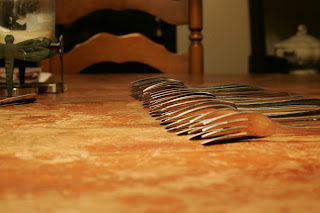Before I continue I must admit ignorance. I know the end result, but I have little to no understanding about the science regarding depth of field, and I really don't want to know. I will use the word "focus" to discuss the end result, but it actually has to do with the way light is interpreted in camera not with camera focus. I will also use the word sharp. For those of you who want to understand the workings, I applaud you, but I'm not going to deal with it here.
Depth of field defined by me is the part of the photograph that is sharp. With a smaller F-stop less of the photograph will be sharp. It is best understood by using examples.
THis is a picture of forks. It is taken with an F-stop of 1.4. There are not many forks in focus.
THis photograph was taken at F4. There are a few forks in focus.
THis photograph was taken at F8. Almost all the forks are in focus.
This photograph was taken at F22. Everything is in focus.
Just like shutter speed and ISO improper F-stop settings can result in an under/overexposed photograph. With the F-stop set too low the photograph will be overexposed photograph with it set too large the photograph will be underexposed. The other dynamic is the amount of the photograph that is in focus. With a low numbered F-stop less of the photograph will be in focus and with a high numbered F-stop more of the photograph will be in focus. This dynamic is called depth of field.
Depth of field is often used to focus attention, or to detract attention, and opens up many different opportunities for photographers, it is best demonstrated with examples.
These were shot using F4 (F-stop 4) . These photographs are meant to be symbolic of their relationship.
Just like shutter speed and ISO improper F-stop settings can result in an under/overexposed photograph. With the F-stop set too low the photograph will be overexposed photograph with it set too large the photograph will be underexposed. The other dynamic is the amount of the photograph that is in focus. With a low numbered F-stop less of the photograph will be in focus and with a high numbered F-stop more of the photograph will be in focus. This dynamic is called depth of field.
Depth of field is often used to focus attention, or to detract attention, and opens up many different opportunities for photographers, it is best demonstrated with examples.
This photograph was shot with an F-stop of 1.8. It focuses attention on her finger, and should at least make the viewer wonder what the &%(*#$%^ is going on.
Just like in the fork examples here is a use of depth of field to focus attention on the model. The camera was set to F4.
These were shot using F4 (F-stop 4) . These photographs are meant to be symbolic of their relationship.
This photograph was shot at F22. All of it needed to be in focus.
This photograph also was shot at F22 for the same reason.
To conclude F-stop can be used to correct an over/underexposed photograph. For an overexposed photograph the F-stop should have been set to a higher number, allowing less light to get to the sensor. If the photograph was underexposed the photographer should have used a lower number allowing in more light. So now you have three different ways to correct exposure: shutter speed, ISO, and F-stop. There have been more books written on this than there are tics on a coon dog. The trick for the photographer is deciding what to adjust and when. My final post on controlling light will be to summarize.











No comments:
Post a Comment